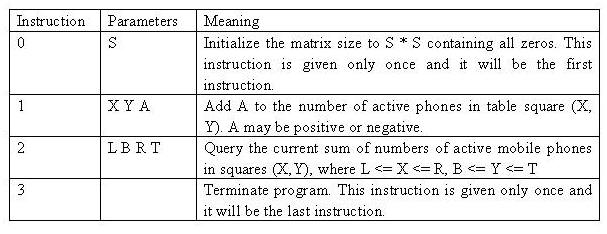Description
Suppose that the fourth generation mobile phone base stations in the Tampere area operate as follows. The area is divided into squares. The squares form an S * S matrix with the rows and columns numbered from 0 to S-1. Each square contains a base station. The number of active mobile phones inside a square can change because a phone is moved from a square to another or a phone is switched on or off. At times, each base station reports the change in the number of active phones to the main base station along with the row and the column of the matrix.
Write a program, which receives these reports and answers queries about the current total number of active mobile phones in any rectangle-shaped area.
Write a program, which receives these reports and answers queries about the current total number of active mobile phones in any rectangle-shaped area.
Input
The input is read from standard input as integers and the answers to the queries are written to standard output as integers. The input is encoded as follows. Each input comes on a separate line, and consists of one instruction integer and a number of parameter integers according to the following table.

The values will always be in range, so there is no need to check them. In particular, if A is negative, it can be assumed that it will not reduce the square value below zero. The indexing starts at 0, e.g. for a table of size 4 * 4, we have 0 <= X <= 3 and 0 <= Y <= 3.
Table size: 1 * 1 <= S * S <= 1024 * 1024
Cell value V at any time: 0 <= V <= 32767
Update amount: -32768 <= A <= 32767
No of instructions in input: 3 <= U <= 60002
Maximum number of phones in the whole table: M= 2^30

The values will always be in range, so there is no need to check them. In particular, if A is negative, it can be assumed that it will not reduce the square value below zero. The indexing starts at 0, e.g. for a table of size 4 * 4, we have 0 <= X <= 3 and 0 <= Y <= 3.
Table size: 1 * 1 <= S * S <= 1024 * 1024
Cell value V at any time: 0 <= V <= 32767
Update amount: -32768 <= A <= 32767
No of instructions in input: 3 <= U <= 60002
Maximum number of phones in the whole table: M= 2^30
Output
Your program should not answer anything to lines with an instruction other than 2. If the instruction is 2, then your program is expected to answer the query by writing the answer as a single line containing a single integer to standard output.
Sample Input
0 4 1 1 2 3 2 0 0 2 2 1 1 1 2 1 1 2 -1 2 1 1 2 3 3
Sample Output
3 4
在S*S的数组中,某些区域的数值是时常变化的,编写程序计算出任意时刻,某一区域的数值和。
输入:
每行一个或多个数字,如果某一行的第一个数字是3时,结束操作;如果某一行的第一个数字是0,那么接下来只有一个数,是S;如果某一行的第一个数字是1时,接下来有三个数,分别是X,Y,A,表示在X,Y对应的点加上A(注意:X,Y可以为0);如果某一行的第一个数字是2时,接下来有四个数,分别是L,B,R,T,表示(L,B)与(R,T)所围区域的和。
解题思路:
利用二维树状数组求解,详细介绍请仔细查看代码及注释。
代码如下:
#include <stdio.h>
#include <string.h>
int S,a[1025][1025];
int lowbit(int x)
{
return x&(-x);
}
//更新二维树状数组,对(x,y)所在元素加num
void updata(int x,int y,int num)
{
int i,j;
for(i=x;i<=S;i+=lowbit(i))
{
for(j=y;j<=S;j+=lowbit(j))
{
a[i][j]+=num;
}
}
}
//求和((1,1)到(x,y)区域的所有元素的和)
int SUM(int x,int y)
{
int i,j,sum=0;
for(i=x;i>0;i-=lowbit(i))
{
for(j=y;j>0;j-=lowbit(j))
{
sum+=a[i][j];
}
}
return sum;
}
int main()
{
int t;
while(scanf("%d",&t)&&t!=3)
{
if(t==0)
{
scanf("%d",&S);
memset(a,0,sizeof(a));
}
if(t==1)
{
int X,Y,A;
scanf("%d%d%d",&X,&Y,&A);
updata(X+1,Y+1,A);
}
if(t==2)
{
int L,B,R,T;
scanf("%d%d%d%d",&L,&B,&R,&T);
printf("%d\n",SUM(L,B)+SUM(R+1,T+1)-SUM(L,T+1)-SUM(R+1,B));
}
}
return 0;
}






















 202
202

 被折叠的 条评论
为什么被折叠?
被折叠的 条评论
为什么被折叠?








